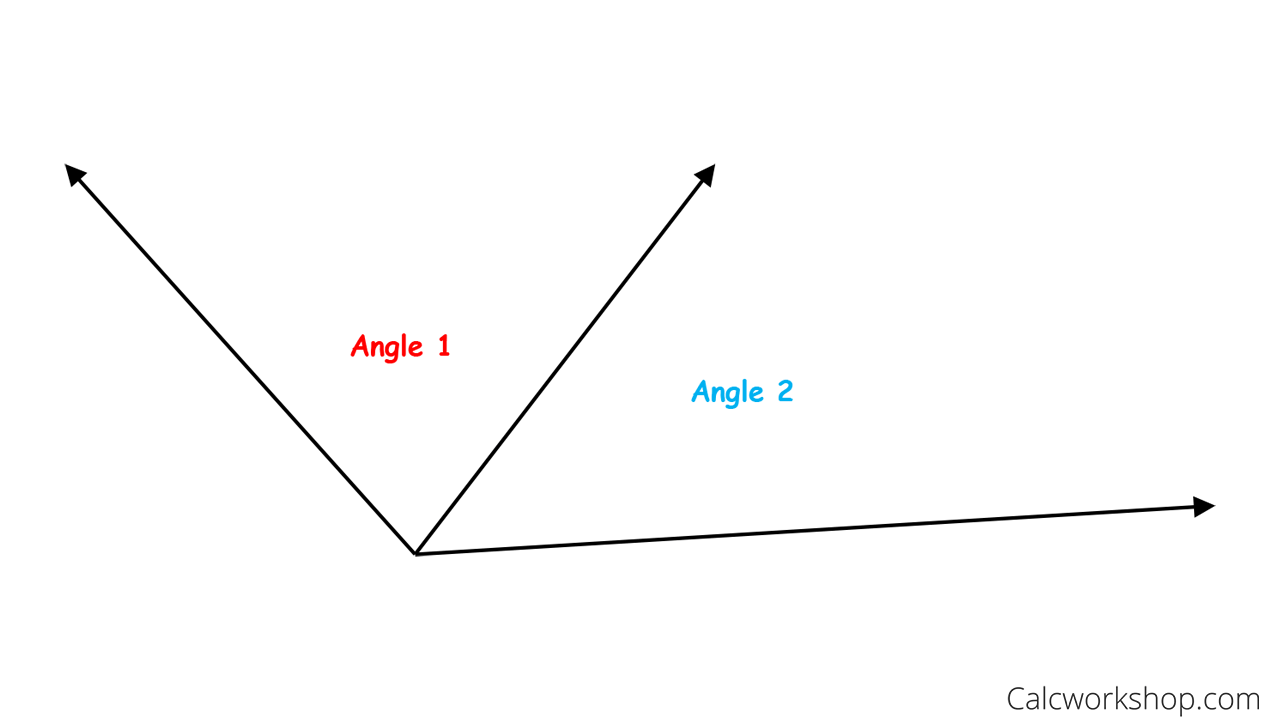In today’s lesson, you’re going to learn all about angle relationships and their measures.

Jenn, Founder Calcworkshop®, 15+ Years Experience (Licensed & Certified Teacher)
We’ll walk through 11 step-by-step examples to ensure mastery.
Let’s dive in!
Angle Pair Relationship Names
In Geometry, there are five fundamental angle pair relationships:
- Complementary Angles
- Supplementary Angles
- Adjacent Angles
- Linear Pair
- Vertical Angles
1. Complementary Angles
Definition
Complementary angles are two positive angles whose sum is 90 degrees.
Examples
For example, complementary angles can be adjacent, as seen in with ∠ABD and ∠CBD in the image below. Or they can be two acute angles, like ∠MNP and ∠EFG, whose sum is equal to 90 degrees. Both of these graphics represent pairs of complementary angles.

Complementary Angles Example
2. Supplementary Angles
Definition
Supplementary angles are two positive angles whose sum is 180 degrees.
Examples
For example, supplementary angles may be adjacent, as seen in with ∠ABD and ∠CBD in the image below. Or they can be two angles, like ∠MNP and ∠KLR, whose sum is equal to 180 degrees. Both of these graphics represent pairs of supplementary angles.

Supplementary Angles Example
What is important to note is that both complementary and supplementary angles don’t always have to be adjacent angles.
3. Adjacent Angles
Definition
Adjacent angles are two angles in a plane that have a common vertex and a common side but no common interior points.
Examples
Angles 1 and 2 are adjacent angles because they share a common side.

Adjacent Angles Examples
And as Math is Fun so nicely points out, a straightforward way to remember Complementary and Supplementary measures is to think:
C is for Corner of a Right Angle (90 degrees)
S is for Straight Angle (180 degrees)
Now it’s time to talk about my two favorite angle-pair relationships: Linear Pair and Vertical Angles.
4. Linear Pair
Definition
A linear pair is precisely what its name indicates. It is a pair of angles sitting on a line! In fact, a linear pair forms supplementary angles.
Why?
Because, we know that the measure of a straight angle is 180 degrees, so a linear pair of angles must also add up to 180 degrees.
Examples
∠ABD and ∠CBD form a linear pair and are also supplementary angles, where ∠1 + ∠2 = 180 degrees.

Linear Pair Example
5. Vertical Angles
Definition
Vertical angles are two nonadjacent angles formed by two intersecting lines or opposite rays.
Huh?
Think of the letter X. These two intersecting lines form two sets of vertical angles (opposite angles). And more importantly, these vertical angles are congruent.
Examples
In the accompanying graphic, we see two intersecting lines, where ∠1 and ∠3 are vertical angles and are congruent. And ∠2 and ∠4 are vertical angles and are also congruent.

Vertical Angles Examples
Together we are going to use our knowledge of Angle Addition, Adjacent Angles, Complementary and Supplementary Angles, as well as Linear Pair and Vertical Angles to find the values of unknown measures.
Angle Relationships – Lesson & Examples (Video)
32 min
- Introduction to Angle Pair Relationships
- 00:00:15 – Overview of Complementary, Supplementary, Adjacent, and Vertical Angles and Linear Pair
- Exclusive Content for Member’s Only
- 00:06:29 – Use the diagram to solve for the unknown angle measures (Examples #1-8)
- 00:19:05 – Find the measure of each variable involving Linear Pair and Vertical Angles (Examples #9-12)
- Practice Problems with Step-by-Step Solutions
- Chapter Tests with Video Solutions
Get access to all the courses and over 450 HD videos with your subscription
Monthly and Yearly Plans Available
Still wondering if CalcWorkshop is right for you?
Take a Tour and find out how a membership can take the struggle out of learning math.